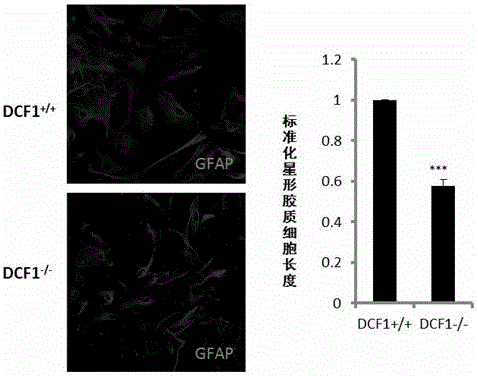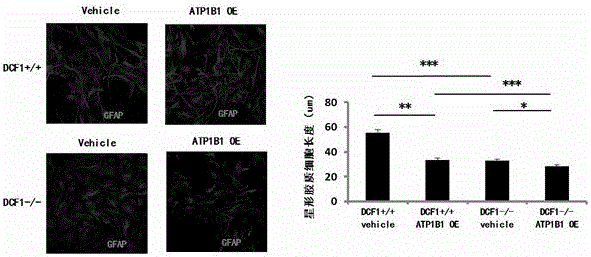Application of dcf1 gene to regulation and control over expression of ATP1B1
A technology of ATP1B1 and gene regulation, applied in the application field of expression, can solve problems such as the decline of learning and memory ability
- Summary
- Abstract
- Description
- Claims
- Application Information
AI Technical Summary
Problems solved by technology
Method used
Image
Examples
Embodiment 1
[0016] Example 1: Cellular immunofluorescence
[0017] Put the newborn rat into a beaker containing absolute ethanol. The amount of absolute ethanol should be able to completely submerge the newborn rat. Observe that the newborn rat is completely immobile and start to take the rat brain. ; Carefully take out the neonatal rat brain, place it in a glass dish pre-cooled with water and pre-cooled PBS, and carefully peel off the hippocampus tissue of the neonatal rat with a pointed tweezers under a stereoscope; transfer the neonatal rat hippocampus tissue to a clean 15ml In the centrifuge tube, use a pipette to gently pipette several times; after observing that the tissue is completely broken, centrifuge it at 4℃, discard the supernatant, add an appropriate amount of pre-cooled 1X PBS, pipette and resuspend, repeat the steps three times; The Neuro medium containing 5% FBS growth factor B-27 and double antibody was gently pipetted to resuspend the cells, 20ul medium was added to 20ul t...
Embodiment 2
[0018] Example 2: Western blotting to detect protein expression
[0019] Transfect HEK293 cells according to different groups. After 48 hours, transfer the cells to a clean 1.5ml centrifuge tube. After washing with PBS, add the lysis buffer that has been pre-added with protease inhibitors (add 400ul lysis buffer to a dish with a diameter of 10cm) After 30 minutes, transfer the tissue / cells to a clean 1.5ml ultracentrifuge tube, balance and centrifuge in an ultracentrifuge at 10,000g at 4℃ for ten minutes; 100ul carefully Transfer the supernatant to a clean 1.5ml centrifuge tube, add 25ul 5X SDS Loading Buffer (1ul mercaptoethanol has been added in advance), mix for a while and incubate in a metal bath at 99°C for 10 minutes; sample can be spotted after instant centrifugation. 80V, 30 minutes; 120V, 90~120 minutes (blue Loading dye to the bottom of the glue); cut out the PVDF glue of appropriate size, and after activation with anhydrous methanol, put it in the transfer liquid with...
PUM
 Login to View More
Login to View More Abstract
Description
Claims
Application Information
 Login to View More
Login to View More - R&D
- Intellectual Property
- Life Sciences
- Materials
- Tech Scout
- Unparalleled Data Quality
- Higher Quality Content
- 60% Fewer Hallucinations
Browse by: Latest US Patents, China's latest patents, Technical Efficacy Thesaurus, Application Domain, Technology Topic, Popular Technical Reports.
© 2025 PatSnap. All rights reserved.Legal|Privacy policy|Modern Slavery Act Transparency Statement|Sitemap|About US| Contact US: help@patsnap.com



